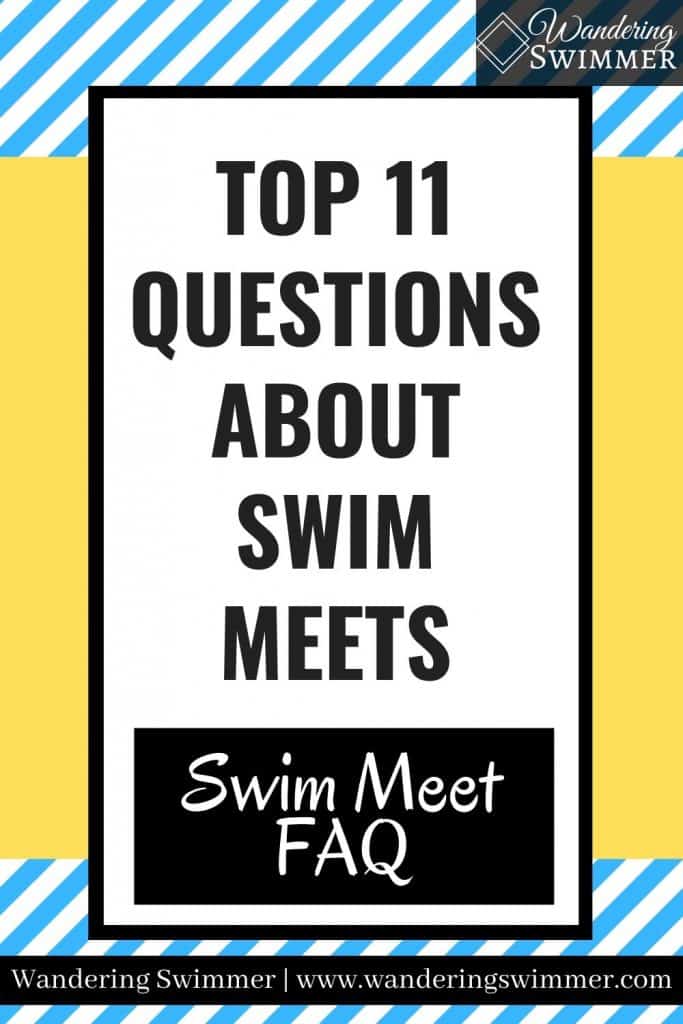For new swimmers, swim meets bring about a variety of questions. And we get it! We’ve all been there before. The first few swim meets can be confusing and even scary. Especially if you don’t know what’s going on.
Related article: What is a Swim Meet?
We’ve been asked several dozen questions about swim meets. Should I compete at a swim meet? (Yes, go for it!) What if I’m the slowest swimmer there? (You keep going and keep dropping time!)
The questions below aren’t a full and comprehensive guide to swim meets. Rather, they’re a brief overview of the top 11 frequently asked questions about swim meets. For other advice and questions, you might have about swim meets, be sure to check out our Swim Meet page!
Disclosure: This post may contain affiliate links, meaning we earn a small commission at no cost to you if you purchase something through one of our links. As an Amazon Associate, we earn from qualifying purchases. Please check out our disclosure page for more information.

Swim Meet FAQ
1. Do Swimmers Need to go to Swim Meets?
We admit that we’re biased on this answer, but we believe it’s important that swimmers participate at swim meets. That’s not to say that you need to attend every swim meet available. But at least 2-4 a season is a good number.
Swim meets provide swimmers with a chance to set goals and then chase after them. They’re also the only place where swimmers can officially drop times and earn cuts.
Related article: Why Are Swim Meets Important?
2. Why Do (Some) Swim Meets Last so Long?
Some, but not all, swim meets can be an all-day affair. What makes a swim meet long depends on several factors. Such as the age of the swimmers, the number of participants, and how many events per day.
The more participants and events in a day, the longer the meet can take. Even meets with the fastest swimmers in the world can take a few hours to complete if there are several hundred participants.
Swim times also play a large role in how long a swim meet can take.
A swim meet might not have many swimmers or events, but they’re only as fast as the slowest swimmer.
On average, most swim meets can easily last up to four hours, if not longer.
And that’s not counting the hours before the meet starts 😉
3. What are Some Important Swim Meet Terms?
There are dozens of swim meet terms that you should know. Some are more important than the rest.
Related article: Easy Swim Meet Terms for Success
Five of those important terms are:
- Event: Name and number of the race
- Heat: Separates swimmers in an event and is comprised of 6-10 swimmers (based upon how many lanes are available).
- Lane: Place where a swimmer will compete in their event and heat. A lane can change throughout the meet
- Touch Pad: White or yellow electronic pad on the wall(s) that registers the time for each swimmer, to include splits and finishes
- Tech/Race Suit: Tech suits refer specifically to suits that are designed for racing based on the fabric, water repellent, reduced drag, etc. Race suit, on the other hand, can refer to a practice suit that’s also used at swim meets. This suit might fit a bit tighter than a different practice suit.
4. Are Parents Allowed on Deck?
Typically, no. USA Swimming rules don’t allow for parents to be on deck unless they’re timing or volunteering.
However, depending on how the natatorium is built, seating for parents might mix with swimmer seating on the deck.
For those natatoriums that have upstairs seating for spectators, parents aren’t allowed on deck.
If the pool doesn’t have upstairs seating though, parents can typically sit with their swimmers in the bleachers. Or in chairs, if they had to bring their own.
But even in these situations, parents aren’t allowed behind the blocks. And they’re usually not allowed to approach the pool past a certain point. Officials and meet volunteers will keep these areas marked off.
5. What are Time Standards?
Time standards are the minimum qualifying time that’s needed to enter a meet.
The meet information will detail what time standards are required for a meet. As a swimmer improves and drops time, they’ll move up to the next time standard.
Within USA Swimming, there are at least 6 different time standards or cuts that a swimmer can earn. From a B Cut (basic time standard and is the first cut a swimmer typically earns), up to an AAAA cut. These are the highest cut a swimmer can earn in age group swimming.
Unfortunately, we can’t speak to the time standards or cuts outside of the US. But if you have questions about time standards in your home country, we encourage you to ask your coach!
6. Why are Heat Sheets Important?
Heat sheets are the guide to every swim meet. They tell swimmers, coaches, and parents what event they’re competing in, and which lane and heat they’re in.
Related articles:
- How to Read a Heat Sheet
- What is a Heat Sheet? (coming soon)
At certain meets, a heat sheet also provides a proposed timeline so swimmers can plan for their events. Even without a timeline, swimmers can get an estimate on when they’ll swim next based on the information in a heat sheet.
Meets may or may not offer a printed copy. Or, you can usually find a copy of the heat sheet online at MeetMobile.
7. Why do Swimmers Write on Their Arms/Legs?
Partly because it’s fun! Swimmers, especially younger swimmers like to write or draw on their legs to support their team. And sometimes to tell other swimmers to ‘eat their bubbles’.
Another reason swimmers write on their arms or legs is to help them remember their events. Along with their heat and lane assignments.
Because swimmers can compete in several events in a day, writing out their events in a grid-like manner keeps everything organized. And hopefully, keep them from missing an event! This also helps some swimmers from panicking and always needing to check the heat sheet.
It’s not at all uncommon to see swimmers checking their arms or legs throughout a meet for reassurance.
8. Do Swimmers Compete in Special Suits, etc.?
Yes and no.
This comes down to personal preference. Some swimmers do have caps and goggles specific for competition. These are typically more streamlined to provide reduced drag while racing. They’re also usually more expensive than goggles and caps used during practice.
Related article:
However, other swimmers are fine with racing in their everyday practice cap and goggles. Again, it’s whatever the swimmer is most comfortable with.
When it comes to swimsuits for meets, it’s a bit more complex.
This can vary by the level of the meet and also by the age of the swimmer. Beginner and younger swimmers typically don’t compete in elite-level tech suits. Just as some swimmers don’t use tech suits for certain meets.
Swimmers can compete in the suit they train in if they feel they meet doesn’t warrant a faster suit. At the same time, some swimmers will always wear a type of tech suit to every meet they compete at.
Ultimately, what a swimmer competes in at a swim meet comes down to what they prefer. And what works best for them. 🙂
9. Why Do Swim Meets Make me Use the Restroom Constantly?
Anxiety and nerves. And trust us when we say, you’re not alone in this.
Most swimmers face varying levels of nerves at swim meets and the body reacts accordingly. This can lead to an elevated heart rate, sweaty palms, and yes, needing to go to the bathroom frequently.
The thing to know is that you shouldn’t be embarrassed by it. It’s not a secret and it’s more common than you think!
10. Should Swimmers Eat at Swim Meets?
They should! However, they need to be smart about what and when they eat.
Because swim meets can last long, swimmers need to eat in between events and after warm-up. Trying to race on an empty stomach doesn’t typically go well. Your body needs energy to race.
Related article: How to Have a Better Swim Meet
At the same time, you can’t compete on a full stomach. Especially one that’s filled with nachos, pizza, and other non-healthy food.
That said, swimmers need to balance what and when they eat. Eating just before a race probably isn’t a good idea. But having a small, healthy snack 30 minutes or so before your race can be easier on your body.
Every swimmer is different though on how they handle food at swim meets. What works for one swimmer might not work for the other. And it’s important to know what works best for you.

11. Can a Swimmer Compete While on their Period?
Absolutely! Hundreds of swimmers will compete while on their period. To include Olympic-level swimmers, too!
Related article: Swimming on Your Period FAQ
Some swimmers have no issue competing while on their period, while others may face some issues. Such as worse cramps or fatigue. There is no one-size-fits-all when it comes to menstruation, especially during swim meets.
That said, we do encourage those swimmers who menstruate to always carry their preferred product with them. If not for yourself, then for another swimmer who might’ve started unexpectedly.
And as always, if you feel concerned about racing at a swim meet during your period, speak with your doctor!
As always, to happy swimming!
Chevron
Bonus Content:
Best Advice for Swim Meets: To help make the most of your next swim meet, we’ve compiled the 14 best pieces of swim meet advice we’ve heard throughout the years.
Swim Meet Etiquette: Swim meets have several unspoken rules for proper swim meet etiquette. Here are 10 tips to ensure your next meet goes smoothly.

Want to Improve at the Pool?
Join swimmers and swim parents to receive my free newsletter and receive a free Swimming Glossary e-book as a thanks!
Every month you’ll receive tips and coaching to help you find success at the pool.